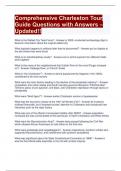Exam (elaborations)
Comprehensive Charleston Tour Guide Questions with Answers – Updated!!
- Course
- Institution
Comprehensive Charleston Tour Guide Questions with Answers – Updated!! What is the Walled City Task Force? - Answer-in 2005, conducted archaeology digs to discover information about the original walled city What typically happens to artifacts after they're discovered? - Answer-put on display ...
[Show more]



